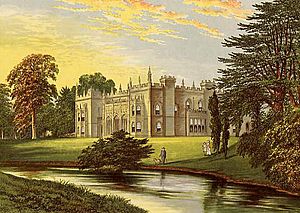William Hiorne facts for kids
William Hiorne (born around 1712 – died April 22, 1776) was a talented architect and builder. He lived and worked in Warwick, a town in England. An architect designs buildings, and a builder constructs them. William Hiorne did both!
He worked with his younger brother, David Hiorne (1715–1758). They learned their skills from another builder named William Smith in Warwick. Later, the Hiorne brothers took over Smith's business. William's son, Francis Hiorne, also followed in his father's footsteps and became an architect. You can find a special memorial for William Hiorne in St Mary’s Church, Warwick.
What Did William Hiorne Build?
William Hiorne was involved in many building projects across England. He helped design and construct churches, grand houses, and other important buildings. His work often involved making changes to existing structures or adding new parts.

Notable Projects and Buildings
Here are some of the interesting places William Hiorne worked on:
- Arbury Hall, Warwickshire (from around 1748): He worked on this large country house, giving it a beautiful Gothic style.
- Shire Hall, Warwick (1754–1758): This important building in Warwick was designed by Sanderson Miller, but Hiorne helped build it. It's a place where local government business happens.
- Holy Cross Church, Daventry (1752–1758): He helped build this church, which is a place of worship.
- St Martin in the Bull Ring (1753 and 1760): He repaired the tall spire of this church and added new rooms.
- Holy Trinity Church, Stratford-upon-Avon (1763–1764): He rebuilt the church's spire using stone. This church is famous as the burial place of William Shakespeare.
Other Works by William Hiorne
William Hiorne also contributed to many other buildings and structures:
- Four Oaks Hall (1740): He helped remodel this hall.
- St Andrew’s Church, Rugby (1744): He created a memorial inside this church.
- St Michael's Church, Coventry (1747): He added new sections around the altar.
- St Bartholomew’s Church, Birmingham (1749): He worked on this church.
- St Margaret’s Church, Acton Scott (1751): He created a memorial for Edward Action.
- Guys Cliffe House (1751): He worked on this historic house.
- Edgbaston Hall, Warwickshire (1751–1752): He made changes inside the hall.
- Rode Hall (1752): He worked on this hall.
- King Edward's School, Birmingham (1752): He fitted out the library.
- Kyre Park, Tenbury Wells (1753–1756): He worked on this park.
- Delbury Hall, Diddlebury, Shropshire (1753–1756): He worked on this hall.
- Derby Country Gaol (1755–1756): He worked on this old prison.
- Meriden Hall, Warwickshire (1757–1758): He added an attic to this hall.
- Packington Hall, Warwickshire (1756–1758): He built the stable-block, designed by Sanderson Miller.
- St Mary's Church, Nottingham (1762): He built a new front section for the church.
- St Leonard's Church, Over Whitacre (1766): He worked on this church.

